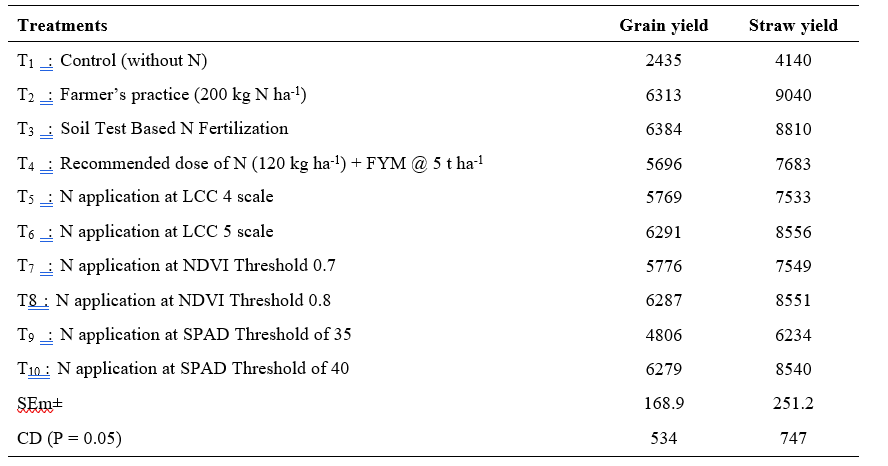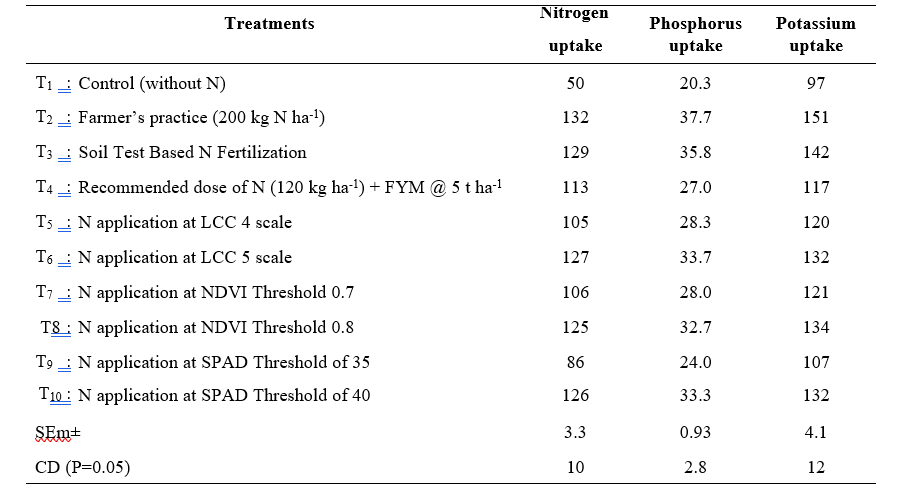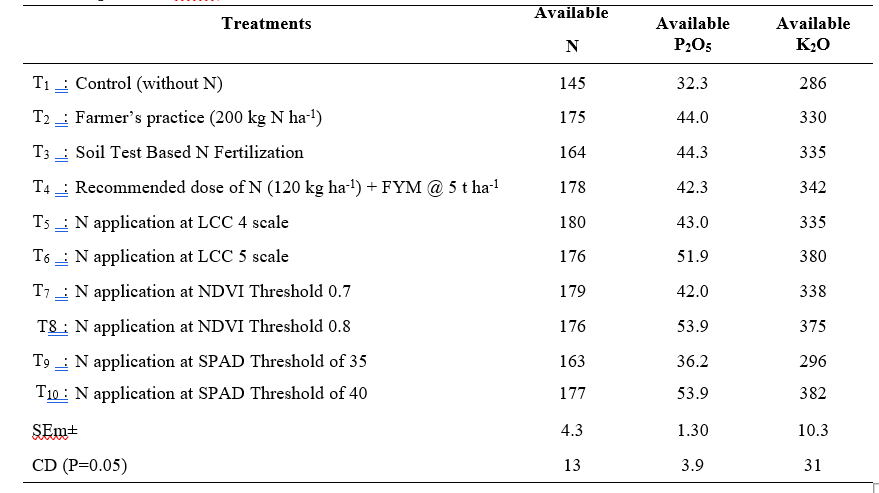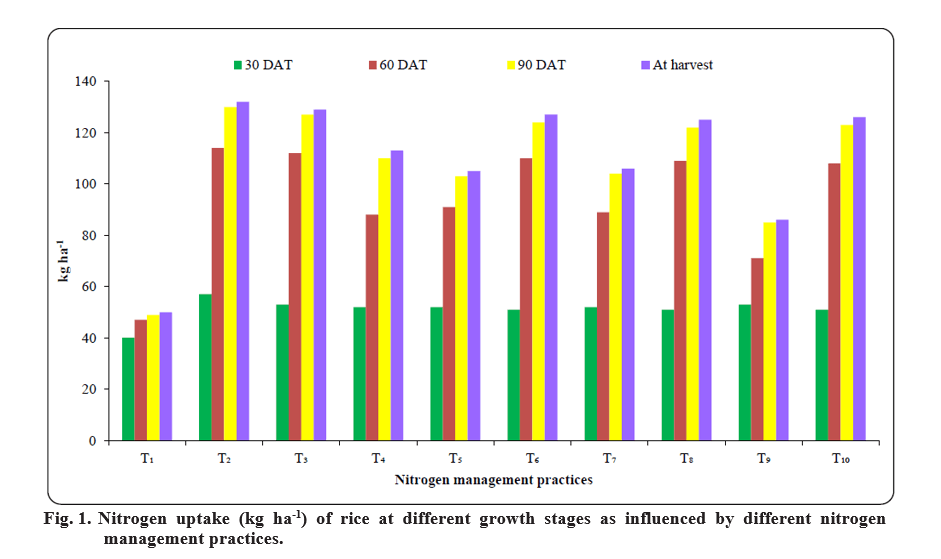Nitrogen Uptake as Influenced by Precision Nitrogen Management In Rabi Rice (Oryza Sativa L.)
0 Views
D. SOWMYA*, S. HEMALATHA, U. VINEETHA, A. PRASANTHI AND G. KARUNA SAGAR
Department of Agronomy, S.V. Agricultural College, ANGRAU, Tirupati-517 502.
ABSTRACT
A field experiment was conducted during rabi, 2021-22 on sandy clay loam soils of Agricultural Research Station, Nellore, Andhra Pradesh to study the “Precision nitrogen management in rabi rice [Oryza sativa L.]”. The experiment was laid out in Randomized Block Design and replicated thrice. The treatments included Control, Farmer’s practice, Soil Test Based Nitrogen Fertilization, Recommended Dose of Nitrogen along with 2 LCC (Leaf color chart), based, 2 NDVI (Normalized difference vegetation index) based and 2 SPAD (Soil Plant Analysis Development) based N management with critical levels of LCC (4,5), NDVI (0.7, 0.8) and SPAD (35, 40). The variety NLR 3354 was tested in the present experiment. Among the different nitrogen management practices tried, higher yield and nutrient uptake was recorded with fixed time nitrogen management in FP and STBNF but was on par with LCC-5 (T6), NDVI-0.8 (T8) and SPAD-40 (T10) with a saving of 45% and 27% of N respectively along with maintenance of high post-harvest soil nutrient status, while significantly lower values were recorded with control (without N) (T1).
KEYWORDS: Farmer’s practice, Soil Test Based Nitrogen Fertilization, Leaf color chart.
INTRODUCTION
Paddy (Oryza sativa L.) is the principal food crop of South East Asian countries and feeds more than half of the global population. Usually, paddy is grown under transplanted submerged condition over a large area.
In India, 45.76 m ha of area is occupied by rice crop with 124.36 m t of production and 2717 kg ha-1 of productivity. In Andhra Pradesh, 2.32 m ha of area is occupied with 7.8 m t of production and 4437 kg ha-1 of productivity. (www.indiastat.com, 2020).
Nitrogen is one of the most important and limited nutrient for rice production, and synthetic nitrogen fertilizer plays a critical role in increasing the yield. However, only 30 to 40% of the applied nitrogen is utilized by the crop resulting in significant losses of reactive nitrogen, which not only reduces production but also drains the national budget and pollutes the environment.
The various methods for fertilizer recommendation based on the analysis of soil and plants are tedious. To avoid the drudgery of the laboratory analysis, scientists have specialized crop sensor technology which gives information on the nitrogen need of a crop based on the leaf optical property. Chlorophyll or N content of leaf is closely related to photosynthetic rate and biomass production, and is an indicator of changes in crop N demand during the growing season. Keeping these in view the present study was formulated to find out the best N management practice.
MATERIALS AND METHODS
A field experiment entitled “Precision nitrogen management in rabi rice [Oryza sativa L.]” was conducted during rabi, 2021-22 at Agricultural Research Station, Nellore. It is geographically situated at 14°27’ N latitude and 79.59’° E longitude and at an altitude of 20 m above MSL in the Southern Agro-climatic Zone of Andhra Pradesh. The present experiment was laid out in Randomized Block Design and replicated thrice. The treatments consisted of ten nitrogen management practices viz., Control (without N) (T1), Farmer’s practice (200 kg N ha-1) (T2), Soil Test Based N fertilizer application (T3), Recommended dose of N (120 kg ha-1) + FYM @ 5 t ha-1) (T4), N application at LCC 4 scale (T5), N application at LCC 5 scale (T6), N application at NDVI Threshold 0.7 (T7), N application at NDVI Threshold 0.8 (T8), N application at SPAD Threshold of 35 (T9) and N application at SPAD Threshold of 40 (T10). The soil of the experimental field was sandy clay loam, neutral in soil reaction, low in organic carbon (0.46 %) and available nitrogen (202 kg ha-1), high in available phosphorus (56 kg ha-1) and available potassium (425 kg ha-1). The crop was sown at 15 cm x 15 cm spacing.
The variety Nellore dhanyarasi (NLR 3354) was sown on Nov-26. All the other recommended practices were adopted as per the crop requirement. The collected data was statistically analyzed following the analysis of variance for Randomized block design as given by Panse and Sukhatme (1985).
RESULTS AND DISCUSSION
Yield
The grain and straw yields were significantly influenced by different nitrogen management practices. Among them, higher yield of rice was recorded with the application of N through Soil Test Based N fertilizer application (T3) and Farmer’s practice (200 kg N ha- 1) (T2), which were on par with precision nitrogen management practices i.e., LCC-5(T6), NDVI-0.8 (T8) and SPAD-40 (T10) compared to RDN (T4), which in turn maintained parity with LCC-4 (T5) and NDVI-0.7(T7). This was followed by SPAD-35 (T9). Significantly lower grain and straw yield was obtained from control (T1).
During this study, precision nitrogen management practice through LCC-5 (T6), NDVI-0.8 (T8) and SPAD- 40 (T10) supply nitrogen based on crop demand in several splits there by increasing the N uptake which showed favorable effect on cell-division and tissue organization that ultimately improved growth attributing characters like plant height, number of tillers, leaf area and higher SPAD values there by increasing the photosynthetic capacity and lead to higher dry matter production and its accumulation in different parts of plant which in turn lead to higher yield attributing characters like, number of panicles m-2, grain weight panicle-1 and number of filled grains panicle-1 which directly or indirectly might have increased the yield equal to FP and STBNF in which N applied was at a higher rate. Lower yield was recorded with RDN, which maintained parity with LCC- 4 (T5) and NDVI-0.7 (T7), might be due to less N uptake by the crop, as the indigenous N supply was low. No increase in the yield was observed in FP when compared to STBNF indicating the later to be the optimum dose. Among the precision nitrogen management practices the higher yields in case of LCC-5 (T6), NDVI-0.8 (T8) and SPAD-40 (T10) compared to other critical levels is due to application of nitrogen in more number of splits which fulfills the crop requirement. These results are in conformity with Ghosh et al. (2013), Mohanty et al. (2015), Prabhudev et al. (2017) and Suresh et al. (2017).
Table 1. Grain and straw yield of rice as influenced by different nitrogen management practices

Table 2. Nutrient uptake (kg ha-1) of rice at harvest as influenced by different nitrogen management practices

Table 3. Post-harvest soil available nutrient status (kg ha-1) as influenced by different nitrogen management practices inrice


Nutrient uptake at harvest
During the study, among the treatments higher Nitrogen, phosphorus and potassium uptake was recorded with FP (T2) and it was on par with STBNF and precision nitrogen management practices i.e., LCC- 5 (T6), NDVI-0.8 (T8) and SPAD 40 (T10) compared to RDN, which maintained parity with LCC-4 (T5) and NDVI-0.7 (T7), followed by SPAD-35(T9). Significantly lowest nutrient uptake was recorded with absolute control (T1) without N. Nutrient uptake is a function of yield and nutrient concentrations in plant. Significant improvement in uptake of nitrogen might be attributed to the respective higher concentration in grain and straw and associated with higher grain and straw yields. Better availability of nitrogen in the soil under these treatments may influenced on higher degree of root proliferation, anchorage and deep penetration and in turn resulted in absorption of higher amount of nutrients from the rhizosphere and supplied to the crop. Even though precision N management practice through LCC-5(T6), NDVI-0.8 (T8) and SPAD-40 (T10) received less amount of N than fixed time N management practice i.e., FP and STBNF but the N uptake was comparable. This was mainly due to N application in more number of splits based on crop demand which reduces various losses such as leaching, volatilization and removal by the weeds there by increasing the crop uptake. Similar findings were also reported by Similar results were perceived by Shantappa et al (2014), Das and Sahu (2015) and Reena et al. (2017)
Post-harvest soil nutrient status Available nitrogen
During the study, the post-harvest soil available nitrogen status of precision N management practices were found to be comparable with each other except SPAD-35 (T9) and were at par with FP and RDN but significantly superior than STBNF. Significantly lower N availability was observed with control (without N) (T1). Adequate and timely supply of nitrogen to meet the crop demand along with increased microbial activity in these treatments might have hastened the process of mineralization during the crop growth period resulting in high accumulation of N in soil. These results strongly support the findings of Arvind et al. (2004) and Swamy et al. (2016).
Available phosphorus and potassium
Significantly higher phosphorus and potassium availability were observed with LCC-5 (T6) NDVI-0.8 (T8) and SPAD-40 (T10), followed by RDN (T4) which was comparable with all other treatments except SPAD-35 (T9) and control (T1). The lower available phosphorous and potassium were noticed in control which maintained parity with SPAD-35 (T9). Application of nitrogen through LCC-5 (T6), NDVI-0.8 (T8) and SPAD-40 (T10) matches with the crop demand as it was applied in more splits in the form of urea which on nitrification forms hydrogen ions besides nitrate ions, thus modifies pH of the rhizosphere, due to this acidification of rhizosphere resulted in the solubilization of insoluble phosphates and release more orthophosphates in to the soil solution. Moreover, higher concentration of nitrates in the soil solution exchange for orthophosphate ions by anion exchange phenomenon. These results are in line with Krishnakumar and Haefele (2013).
Increased status of potassium might be due to enhanced mineralization owing to better root growth under LCC-5 (T6) NDVI-0.8 (T8) and SPAD-40 (T10), which maintained parity with each other. Results of the present investigation strongly support the findings of Duttarganvi et al. (2011) and Rao et al. (2016).
It is concluded that the application of 30 kg N ha-1 as basal and 20 kg N ha-1 guided either by LCC-5 (T6) or NDVI-0.8 (T8) or SPAD -40 (T10), proved to be most promising, feasible and economically viable nitrogen management practice for higher yield and economics in rabi rice for the Southern Agro-climatic Zone of Andhra Pradesh.
LITERATURE CITED
Arvind, K., Shukla, Jagdish, K., Ladha, Singh, V.K., Dwivedi, B.S., Vethaiya, B., Raj, K., Gupta, S.K., Sharma, Yogendra, S., Pathak, H., Pandey, P.S., Agnes, T., Padre and Yadav, R.L. 2004. Calibrating the leaf color chart for nitrogen management in different genotypes of rice and wheat in a systems perspective. Agronomy Journal. 96(2): 1606-1621.
Das, I and Sahu, N.C. 2015. Nitrogen management by using leaf colour chart in kharif rice in alluvial soils of West Bengal. Journal of Krishi Vigyan. 3(2): 69-72.
Duttarganvi, S., Channabasavanna, A.S., Halepyati, A.S., Nagalikar, V.P., Satyanarayana, R and Vasudevan,
S.N. 2011. Economic adoptability of leaf colour chart and chlorophyll meter in nitrogen management in lowland rice (Oryza sativa L.). Karnataka Journal of Agricultural Sciences. 24(4): 531-532.
Ghosh,M.,Dillip,K.S.,Madan,K.JandVirendra,K.T.2013. Precision nitrogen management using chlorophyll meter for improving growth, productivity and N use efficiency of rice in Subtropical climate. Journal of Agricultural Sciences. 5(2): 253-266.
Krishnakumar, S and Haefele, S. 2013. Integrated nutrient management and LCC based nitrogen management on soil fertility and yield of rice (Oryza sativa L.). Scientific Research and Essays. 8(41): 2059-2067.
Mohanty, S.K., Singh, A.K., Jat, S.L., Parihar, C.M., Pooniya, V., Sharma, S., Sandhya., Chaudhary, V and Bahadur, S. 2015. Precision nitrogen management practices influences growth and yield of wheat (Triticum aestivum) under conservation agriculture. Indian Journal of Agronomy. 60 (4): 617-621.
Panse, V.G and Sukhatme, P.V. 1985. Statistical methods for Agricultural Workers. Indian Council of Agricultural Research, New Delhi. 87-89.
Prabhudev, D.S., Nagaraju, Sheshadri, T., Basavaraja, P.K., Timmegouda, M.N and Mallikarjuna, G.B. 2017. Precision management practices – a much needed set of agro-techniques to improve rice productivity and cutback the resources in aerobic rice condition under drip irrigation. International Journal of Current Mirobiology and Application Sciences. 6(8): 2800-2810.
Rao, V.P., Subbaiah, G and Veeraraghavaiah, R. 2016. Productivity and nutrient uptake of rice fallow maize (Zea mays L.) as influenced by plant density and fertilizer under no till conditions. International Journal of Current Microbiology and Applied Sciences. 5(6): 826-836.
Reena, V.C., Dhyani., Sumit, C and Himansu, S.G. 2017. Growth, yield and nitrogen use efficiency in wheat as influenced by leaf colour chart and chlorophyll meter based nitrogen management. International Journal of Current Microbiology and Applied Sciences. 6(12): 1696-1704.
- Bio-Formulations for Plant Growth-Promoting Streptomyces SP.
- Brand Preference of Farmers for Maize Seed
- Issues That Consumer Experience Towards Online Food Delivery (Ofd) Services in Tirupati City
- Influence of High Density Planting on Yield Parameters of Super Early and Mid Early Varieties of Redgram (Cajanus Cajan (L.) Millsp.)
- Influence of Iron, Zinc and Supplemental N P K on Yield and Yield Attributes of Dry Direct Sown Rice
- Effect of Soil and Foliar Application of Nutrients on the Performance of Bold Seeded Groundnut (Arachis Hypogaea L.)

